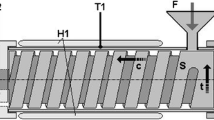Abstract
General purpose poly(styrene) is a large volume commodity polymer widely used in a range of applications. For many of these the presence of an additive to impart some flammability resistance is required. Most commonly, brominated aromatics are used for this purpose. As the polymer undergoes combustion these compounds decompose to generate bromine atoms and/or hydrogen bromide which escape to the gas phase and trap flame propagating radicals. While these species are effective in inhibiting flame propagation they present the opportunity for loss of halogen to the atmosphere. For this reason, the use of these compounds is being limited in some parts of the world. Phosphorus compounds, on the other had, impart a flame retarding influence by promoting char formation at the surface of the burning polymer. This prevents heat feedback to the polymer and consequent pyrolysis to generate fuel fragments. The combination of both bromine and phosphorus present in a single compound might generate a superior flame-retarding additive in that both modes of retardancy might be promoted simultaneously. Should this be the case smaller amounts of additive might be necessary to achieve a satisfactory level of flame retardancy. A series of such additives, brominated aryl phosphates, has been synthesized and fully characterized spectroscopically. Blends of these additives, at various levels, with poly(styrene) have been examined by DSC, TG and in the UL-94 flame test. The flammability of the polymer is dramatically diminished by the presence of the additive.
Similar content being viewed by others
References
Chemical and Engineering News, 83 (2005) 28 (May 16, 2005).
A Tewarson (1997) J. Fire Flammability 8 115
A Pettigrew (1993) Halogenated Flame Retardants, in Kirk-Othmer, Encyclopedia of Chemical Technology, 4th Ed., Vol. 10 John Wiley and Sons, Inc. New York
ED Weil S Levchik (2004) J. Fire Sci. 22 339 Occurrence Handle10.1177/0734904104042188
ED Weil (1997) Encylclopedia of Chemical Technology, Vol. 10 Wiley New York 397
M Doering C Kollann U Storzer M Ciesielski U Dittrich J Bertold K Holgar K Heinemann E Mensel (2005) Proceedings, 16th Annual Conference on Advances in Flame Retardancy of PolymericMaterials Business Communications Company, Inc. Norwalk
DB, Denny and FJ, Gross, J. Chem. Soc. Perkin I, (1967) 2445.
BA Howell Y Cui DB Priddy (2004) J. Therm. Anal. Cal. 17 313 Occurrence Handle10.1023/B:JTAN.0000027830.41269.eb
LC Thomas (1974) Interpretation of the Infrared Spectra of Organophosphorus Compounds Adacemic Press London 46
Author information
Authors and Affiliations
Corresponding author
Rights and permissions
About this article
Cite this article
Howell, B.A., Cho, YJ. Thermal properties of poly(styrene) containing brominated aryl phosphate additives. J Therm Anal Calorim 85, 73–78 (2006). https://doi.org/10.1007/s10973-005-7335-y
Received:
Accepted:
Published:
Issue Date:
DOI: https://doi.org/10.1007/s10973-005-7335-y




